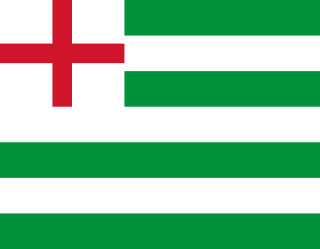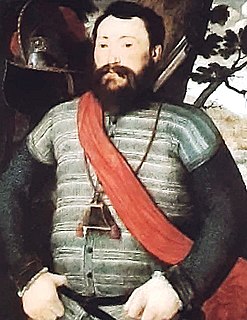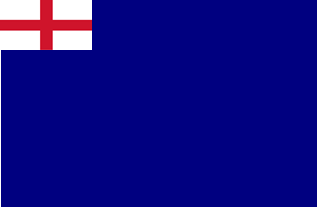Sir Robert de Herle was an English military commander who was Admiral of all the Fleets about England and Lord Warden of the Cinque Ports during the mid-14th century.

The Tudor navy was the navy of the Kingdom of England under the ruling Tudor dynasty (1485–1603). The period involved important and critical changes that led to the establishment of a permanent navy and laid the foundations for the future Royal Navy.

The Surveyor of the Navy also known as Department of the Surveyor of the Navy and originally known as Surveyor and Rigger of the Navy was a former principal commissioner and member of both the Navy Board from the inauguration of that body in 1546 until its abolition in 1832 and then a member Board of Admiralty from 1848-1859. In 1860 the office was renamed Controller of The Navy until 1869 when the office was merged with that of the Third Naval Lord's the post holder held overall responsibility for the design of British warships.

Vice-Admiral Thomas Wyndham (1508–1554) was an English naval officer, naval administrator, explorer, and navigator. He was appointed a member of the Council of the Marine as one of the Chief Officers of the Admiralty in 1552 and given the title of Master of Naval Ordnance and was simultaneously a member of the Board of Ordnance until 1553.
Vice-Admiral Sir William Gonson (1482–1544), was a Naval Judge and Naval Administrator of the English Royal Navy who served under King Henry VIII.
Lieutenant Admiral Sir William Woodhouse was an English naval commander and administrator who rose to the rank of Lieutenant of the Admiralty and was head of the Council of the Marine later called the Navy Board. He also served as a Member of Parliament of the Parliament of England from 1545 to 1564. He was prominent during an important time of the Navy Royal's development in the later half of Tudor period.

The Admiralty and Marine Affairs Office (1546-1707) originally known as the Admiralty Office (1414-1546) was a government office of the Kingdom of England and the English Navy's central command. It was first established in 1414 when the remaining regional admiralties, the Northern and Western were abolished and their functions were unified under a single centralized command. It was administered by the Office of the High Admiral of England, Ireland and Aquitaine later called the Lord Admiral of England. During the sixteenth century it oversaw the creation of standing "Navy Royal", with its own secretariat, dockyards and a permanent core of purpose-built warships, originated in the early 16th century during the reign of Henry VIII. Under Elizabeth I England became involved in a war with Spain, which saw privately owned ships combining with the Royal Navy in highly profitable raids against Spanish commerce and colonies. In 1588, Philip II of Spain sent the Spanish Armada against England to end English support for Dutch rebels, to stop English corsair activity and to depose the Protestant Elizabeth I and restore Catholicism to England. The Spaniards sailed from Lisbon, planning to escort an invasion force from the Spanish Netherlands but the scheme failed due to poor planning, English harrying, blocking action by the Dutch, and severe storms. A Counter Armada, known as the English Armada, was dispatched to the Iberian coast in 1589, but failed to drive home the advantage England had won upon the dispersal of the Spanish Armada in the previous year. The Admiralty of England existed until 1707 when Kingdom of England and the Kingdom of Scotland united to form the single Kingdom of Great Britain when it then became known as the Admiralty Department or Admiralty of Great Britain.

During the early 17th century, England's relative naval power deteriorated, In the course of the rest of the 17th century, The office of the Admiralty and Marine Affairs steered the Navy's transition from a semi-amateur Navy Royal fighting in conjunction with private vessels into a fully professional institution, a Royal Navy. Its financial provisions were gradually regularised, it came to rely on dedicated warships only, and it developed a professional officer corps with a defined career structure, superseding an earlier mix of sailors and socially prominent former soldiers.

The Navy Office was the government office responsible for the civil administration of the British Royal Navy from 1576 to 1832. It contained all the members of the Navy Board and various other departments and offices. The day-to-day business of the Navy Office was headed by the Clerk of the Acts from 1660 until 1796. When this position was abolished duties were assumed by separate committees for Accounts, Correspondence, Stores, Transports and Victualling presided over by the Comptroller of the Navy. The Navy Office was one of two government offices that were jointly responsible for directing naval affairs. In 1832 following reforms of the naval service the Navy Office was abolished and its functions and staff taken over by the Admiralty.

The Admiral of the Narrow Seas also known as the Admiral for the guard of the Narrow Seas was a senior Royal Navy appointment. The post holder was chiefly responsible for the command of the English navy's Narrow Seas Squadron also known as the Eastern Squadron that operated in the two seas which lay between England and Kingdom of France and England and the Spanish Netherlands later the Dutch Republic from 1412 to 1688. His subordinate units, establishments, and staff were sometimes informally known as the Command of the Narrow Seas.
The Commander-in-Chief, English Channel or formally Commander-in-Chief, of His Majesty's Ships in the Channel was a senior commander of the Royal Navy. The Spithead Station was a name given to the units, establishments, and staff operating under the post from 1709 to 1746. Following Admiral Lord Anson new appointment as Commander-in-Chief, English Channel this office was amalgamated with the office of Commander-in-Chief, Portsmouth.
Erith Dockyard located at Erith, Kent, England was an early Tudor naval dockyard operated by the English Navy that opened in 1512 due to persistent flooding the dockyard closed in 1521.

The Keeper of the Storehouses and formally known as the Keeper of the King's Storehouses was an English Navy appointment created in 1524 the office holder was a principal member of the Council of the Marine from 1546 until the post was abolished and his duties assumed by the Treasurer of the Navy in 1560. He was responsible for the storing and supply of naval stores at naval dockyards for the navy.
Admiral Sir John Malyn or Malen, was a seaman, shipowner and later senior officer of the English Navy Royal who served under Henry VIII, Edward VI and Mary I. He died at sea off the coast of Rye, East Sussex, England whilst in command of his ship HMS Grehound that was wrecked after hitting an unseen sandbar.
Admiral Sir Gervase Alard, Bart. (1270–1340), was an English knight and naval commander who was appointed Admiral of the Cinque Ports Fleet and Admiral of the Western Fleet of the English Navy who served under King's Edward I, Edward II and Edward III of England from 1296 to 1340.
John Hopton was an English naval officer and naval administrator who was appointed the first Clerk Comptroller of the Navy (1512–1524). He was one of the Clerks of His Majesty's Kings Marine who served under King Henry VIII of England.

The Irish Squadron originally known as the Irish Fleet was a series of temporary naval formations assembled for specific military campaigns of the English Navy, the Navy Royal and later the Royal Navy from 1297 to 1731.
Admiral Sir Robert Morley or Robert de Morley, 2nd Baron Morley, was an English Knight and naval officer who served as Admiral of the North four times from in the service of King Edward III.
Admiral Sir Peter Bard was an English Knight and naval officer who held a number of important commands of the Navy Royal from 1314 to 1336. and Admiral of the West from 1314 to 1315 and again from 1338 to 1339. Vice-Admiral of the West in 1337. and Admiral of the Fleet of the Cinque Ports from 1335 to 1336.

The Channel Squadron also referred to as the Western Squadron (1512-1649) was a series of temporary naval formations first formed in under the English Tudor Navy Royal during the sixteenth century. Later during the Interregnum a channel squadron was formed as part of the Commonwealth Navy. During the 18th century as part of the Royal Navy.








